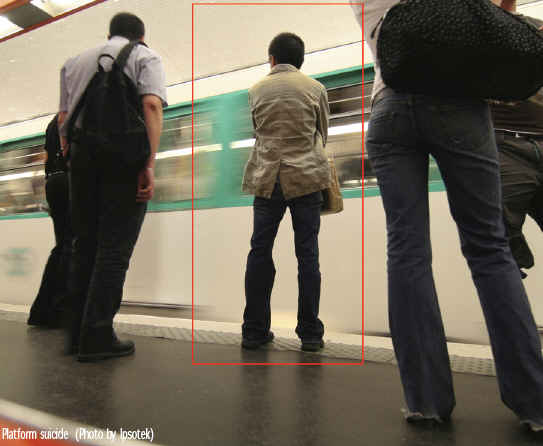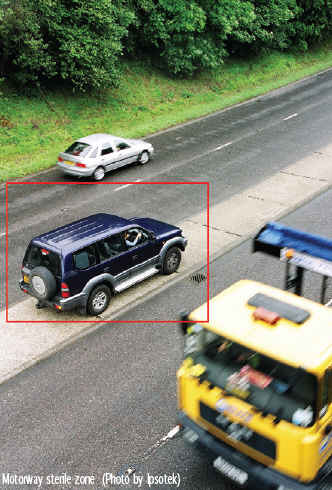By Chris Gomersall

Referred to variously as ‘intelligent video surveillance’ or ‘intelligent scene analysis’, video analytics employs algorithms and vector partitioning to detect unexpected movement or unusual behavior that may pose a threat to people, property and infrastructure. The software filters and interprets data captured by CCTV cameras in circumstances where a human observer would struggle to assess developments as they arise. The analysis can be performed in real-time or retrospectively in playback for evidential purposes. Real-time messages on potential risks or situations requiring attention can take the form of audible and visual alarms, on-screen alerts, SMS messaging and direct communication with emergency services.
Common scenarios observed by analytics suites include border security, abnormal pedestrian or vehicular motion, suspect packages, platform suicide and many forms of street crime or deviation from social norms. Such deviation can cover prostitution, kerb crawling, drug dealing and trackside intrusion.
Leading suppliers of scene analysis such as Ipsotek, who has been working in this field since 1995, have built up a flexible core of behavioral algorithms to create numerous generic and client-specific alarm triggers. These can cover complex needs or be as simple as surveillance of a sterile zone. In addition to the scenarios described above, usage can include prevention of ATM surfing, graffiti, vandalism, tailgating, loitering, theft of museum artefacts, station or stadium overcrowding and platform suicide.
COMBATING OPERATOR FATIGUE
A principal benefit of video analytics is that it removes the problem of operator fatigue. Estimates vary but published figures indicate that after 20 minutes the ability of even a well-motivated security guard to concentrate on a monitor screen drops by 90%. Mechanized observation not only eliminates human error but requires a low ratio of monitors to cameras with attention being focused on known ‘hotspots’ and previously identified issues. The technology also produces savings in review processes since less time is spent observing eventless footage and false alarms are minimized. Expenditure on human resources is reduced dramatically since the number of cameras to operator (typically more than 1:100) is high.
A video analytics software suite can be ‘taught’ to discriminate between movement that is meaningful and motion such as a swaying tree that is an integral part of the environment and not a threat. Thus, swaying foliage which might need to be masked out of the scene when using cruder systems can be distinguished from salient movement such as an intruder penetrating a location from the same piece of wind-effected woodland.
A sophisticated video analytics suite can overcome occasional picture break-up and interference (known to video engineers as ‘noise’) without producing nuisance alarms. Low levels of ambient light and varying weather conditions can also be accommodated by an analytics suite that has been carefully configured. Cutting-edge analytics uses object tracking to evaluate individual objects and track them. The technology’s ability to chart the movement of a single suspect in a crowded scene through vector analysis is perhaps the crucial development that is making analytics a viable approach in public spaces.
COMBINING AUDIO WITH VIDEO ANALYSIS
A crucial step forward for the analytics sector has been the use of audio analysis in tandem with video analysis. Currently, Ipsotek is the only company in the world that offers true integration of both media. Audio analysis can cover detection of gunshots and airplanes as well as the sound of abnormal mechanical processes such as a car engine malfunctioning.
A common inner-city application is detection of shouting or screaming consistent with assault or rape. Effective audio analysis frequently allows security officers to intervene before an incident escalates and the analysis can be invaluable for evidential purposes. There is also much scope for applications within transport infrastructure and recent audio analysis at Schipol Airport in the Netherlands revealed that a significant proportion of the noise cited by residents as emanating from aircraft was in fact produced by vehicles on an adjacent motorway.
As with video analysis, false alarms in the audio field are an anathema to the end-user and damage the credibility of the technology.
DISTINGUISHING AGGRESSION
Ipsotek has invested extensively in the development of algorithms based on 12 major audio cues which assist in detecting the change in pitch, distortion of voice and constriction of larynx muscles that characterize a genuine confrontation as opposed to an everyday argument. It is almost impossible to fake these muscular changes and to date, only one method-trained actress has ‘deceived’ the system during testing.
It is in social deviance that video analytics holds out massive potential for central and local government. For many years the CCTV sector’s ability to provide security officers with almost limitless video footage has far outstripped the ability of operators to interpret that footage. High-quality, intelligent video analytics has changed this, and a gamut of situations indicating undesirable social behavior can be assimilated by the software to create alarms.
Ipsotek, for example, is currently working with local government in east London and its software noted a repeated scenario where a pair of youths were being approached by other young people and a brief physical exchange suggesting a transaction was taking place. Using its innate intelligence, the software created an alarm on this behavior as warranting investigation and its research engineers have since created a drug dealing scenario.
PATTERN OF MOVEMENT
Kerb-crawling and prostitutes working from cars are examples where pattern of movement can be used to cue an alarm. Posture and movement are also relevant to car theft and a correctly configured analytics device in a parking lot will be able to distinguish between the legitimate behavior of a driver walking straight to his car and unlocking it with the contrasting behavior of a criminal hovering near a succession of vehicles and assessing them before attempting a break-in.
Public concern over street security, particularly anti-social behavior, continues to escalate across Europe. Video analytics now offers viable solutions for reducing social disturbance and Ipsotek will soon be developing an ‘ASBO’ package. The acronym stands for Anti-Social Behavior Order, a legal measure (unique to the U.K.) that seeks to prevent young people with a track record of misbehavior from re-offending by imposing curfews and banning them from certain civic spaces. I believe that intelligent scene analysis is about to bring massive benefits to civil servants and law enforcement bodies who are sufficiently far-sighted to recognize the potential of the technology in this area.
RESEARCH AND DEVELOPMENT
Analytics suppliers are currently addressing myriad scenarios in both the commercial and public sectors. If the software is to continue to keep pace with the variety of tracking demanded by end-users, algorithms and behavioral analysis must develop continually since the type of deviation from normal behavior against which clients wish to discriminate is infinite. Some user needs verge on the bizarre and Ipsotek recently received a request from a client who wished to use audio analytics to detect sectarian chanting at football matches.
Leading companies invest heavily in research and development by maintaining close links with the academic community. Ipsotek is working with the digital imaging research center at Kingston University in south-west London and there are currently two strands to the relationship.
PRINCIPAL BENEFITS
One of the principal benefits of video analytics is that it can be installed to work with legacy CCTV systems and analogue cameras. Providing video footage is transmitted to a suitable digital video recorder or network video recorder there is no necessity for IP-addressable cameras though network-addressable systems are of course becoming increasingly common. The financial savings on manned guarding and control room staff are enormous and in a recent development, an Ipsotek client in the estate management sector has expanded its use of video analytics at a cost of US$55,000 when a comparable increase in manned guarding would have cost in excess of US$88,000 with the surveillance being performed at a demonstrably inferior level.
As analytics continues to improve and the leading providers respond resourcefully to a broad range of user demands, scene analysis will gain wider acceptance in both government and commercial spheres. The scenarios detected will become increasingly subtle, allowing innovative end-users to improve public safety by employing this exciting technology.

Chris Gomersall is CEO of Ipsotek (www.ipsotek.com).
For more information, please send your e-mails to swm@infothe.com.
ⓒ2007 www.SecurityWorldMag.com. All rights reserved.
|



